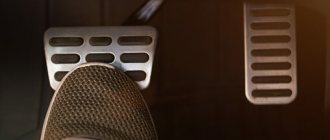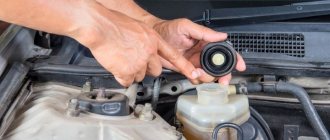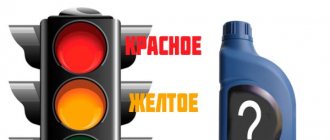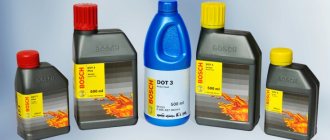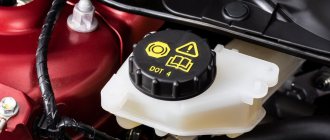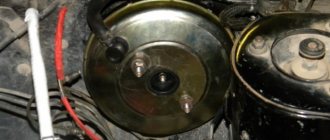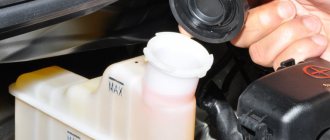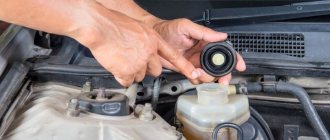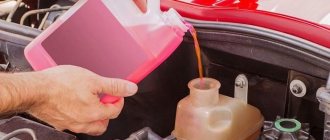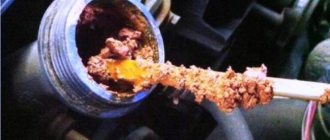Brake fluid with different bases are incompatible with each other, they separate, and sometimes sediment appears. The parameters of this mixture will be lower than those of any of the original liquids, and its effect on rubber parts is unpredictable. The manufacturer usually indicates the basis of the TJ on the packaging. Russian Ros DOT, “Neva”, “Tom”, as well as other domestic and imported polygonal liquids DOT3, DOT 4 and DOT 5.1, can be mixed in any proportions. TJ class DOT 5 are based on silicone and are incompatible with others. Therefore, the FM VSS 116 standard requires that “silicone” liquids be painted dark red. The remaining modern TJs are usually yellow (shades from light yellow to light brown). For additional testing, you can mix the liquids in a 1:1 ratio in a glass container. If the mixture is transparent and there is no sediment, the liquid liquids are compatible. It should be remembered that mixing liquids of different classes and manufacturers is not recommended, as their properties may change. It is forbidden to mix glycol fluids with castor fluids.
5.3 Marketing retreat
DOT 3, DOT 4 and DOT 5.1 fluids are hygroscopic, meaning that they absorb moisture from the air. The presence of moisture in the fluid lowers its boiling point; the operating temperature of the brake disc and pads usually exceeds it. That is why the boiling point of dry and moisture-containing fluid is indicated. The boiling point of wet fluid is measured at a moisture content of 3.5% Hygroscopicity is the reason for the need to replace brake fluid at least once every two years. The friction material on the brake pad serves to insulate the caliper from the heat generated by the disc, which is a very important reason to replace the pads long before they wear out. DOT5 liquid is not hygroscopic and does not mix with water. When water enters the system, it sinks down and is located near the hottest area of the system. This means that it will boil very easily and quickly, forming gas bubbles that are easily compressed, which in turn gives the brakes a springy feel. Another problem with DOT 5 is that the liquid itself becomes compressible as it approaches boiling point; This leads to a feeling of elasticity in the brakes with frequent and prolonged use.
Today in our market you can find many imported brake fluids (Brake Fluid). If such a fluid is recommended by the manufacturer for any car and is marked DOT-3 or DOT-4, then it can be used equally in foreign cars and domestic cars. It can also be argued that the composition of this product includes various esters, low molecular weight polymers and targeted additives. As for performance qualities (including temperature properties), when compared in the corresponding class (DOT-3 or DOT-4), imported liquids are approximately identical to our “Tom” or “Rosa” and do not have any special differences from them.
Imported drugs are widely represented on the market. When choosing, the main criterion is compliance with the requirements of the DOT class recommended for a particular vehicle (for NivaDOT-4).
In my opinion, using imported fluids in Niva makes little sense. Corrosion of the brake system is more active from the outside, and the remaining properties are identical to Rosa.
And finally, for the most curious, some car companies use brake fluids based on mineral oil. They are not hygroscopic, do not provoke corrosion and last longer than their counterparts with glycol starter. They are very rare and expensive.
Didn't find what you were looking for? Use the search:
Modern brake fluids are quite technologically advanced; they can withstand high temperatures, as well as high pressure in the brake system of a modern car. They are not compressible and therefore they are used in the braking system of a car, that is, compressing, like gas or air, cannot be done. That is why the car’s system is liquid; it has proven its reliability (in fairness, it is worth noting that there are also pneumatic options). BUT, the hydraulic option still has some minor drawbacks - it can leak, for example, if the brake hose breaks, but you still need to drive! But what to do if you don’t have exactly the same composition as you (the original was filled in from the dealer)? Then a fair question arises - is it possible to mix brake fluid from different manufacturers and different classes, say, pour DOT3 into DOT4 - what will happen? As usual, the article will be extensive + video version at the end, so read and watch...
Dry and wet mixture
At the very beginning, I would like to talk about the hygroscopicity of brake fluid (for those who don’t know, this is the ability to absorb moisture from the environment). That is why it must be changed after a certain period of time, on average every 2 - 4 years, it all depends on the class (more on this below).
So, when you have just opened a sealed jar (which has not had contact with the surrounding air), and want to pour it into the main tank, then this composition will be called DRY , because there is no moisture there at all! After all, it just opened.
But if your car or open can was in contact with air (the can may have been lying open on a shelf for a couple of years). The liquid has already absorbed a large percentage of moisture! Moreover, only 3.5% is enough so that it can no longer be used in the braking system! This mixture is called MOISTURIZED (it simply contains water)!
Basic properties
Brake fluids have a number of characteristics on which their performance directly depends. This:
- hygroscopicity;
- pour point;
- aggressiveness.
The ability of a liquid to absorb moisture depends on the level of hygroscopicity. The lower this figure, the better. This is due to the fact that moisture entering the brake fluid worsens its properties, in particular, lowers the boiling point.
The aggressiveness of the brake fluid determines the extent to which it has a negative effect on gaskets and other system elements made of rubber or plastic.
Pour point is an extremely important parameter. In severe frosts, brake fluid can become extremely thick and stop circulating in the system. In this case, it is difficult for the driver to press the brake pedal and may cause serious problems with driving safety. In Russia, which is famous throughout the world for its cold winters, it is necessary to use a liquid that retains its properties even at low temperatures.
DOT classification
To begin with, what is DOT anyway? If you decipher it, it turns out that the Department Of Transportation (Or Department of Transport) is located in the jurisdiction of the United States. So this department decided to distinguish between different compositions by class - as a result, DOT1 appeared, and then others.
DOT1 - DOT2 - these are the very first brake fluids, they were based on mineral substances, now they are practically not used, so we won’t bother with them, although I will note them for general development. They were used on low-speed vehicles, speeds up to approximately 40 - 60 km/h, and under heavy loads they could boil quite quickly. As a result, they very quickly lost their characteristics.
Now a small remark - ask, why could it boil? Yes, everything is simple: when the car slows down, and the slope is prolonged, the wheel rims can heat up to 350 - 400 degrees Celsius. Part of the heat is transferred to the calipers, and from them to the brake fluid itself. The mineral started to boil already at 140 degrees.
DOT3 is the third class, it was kind of innovative. It already contained a glycolic base. The boiling point of a dry liquid is 230, and a moistened one is 140 degrees .
DOT4 is the fourth class, believe it or not, the third was not enough, especially in a state of moisture. The base is again glycols. The compositions have been slightly modified, and now the characteristics are 240 and 155, respectively . It is worth noting that for most passenger cars at the moment this is enough, but there are cars with powerful engines, heavy bodies and exorbitant speeds.
DOT5.1 is the next class for them (you’ll understand why with the dot later). There is also a glycol component in the base. BUT the temperature threshold is again increased to 260 and 180 degrees actually . However, these compounds are much more expensive, so they are rarely used on budget cars.
How do you understand this, so to speak – the “glycol branch” of development. Such compositions have many advantages, because we need not only boiling, but also lubrication on the inside - these are pistons, seals, cylinders, etc. (it should be noted that seals with glycols work very well and for a long time). Also, these brake fluids are quite stable. That is, they do not have any deviations in characteristics.
The downside is that it needs to be replaced every 2-3 years, because the hygroscopicity is at a very high level. It should be noted that this is a really “fat” minus.
DOT5 is the fifth generation, there is also DOT5.1/ ABS , in fact they are very similar. In general, they were made as something revolutionary; they were supposed to displace the old compositions and become the leader. The thing is that they are based on silicones. The temperature characteristics are approximately similar - 260 for dry and 180 for humidified . But the big plus is the hygroscopicity here, it is not as great as that of opponents! You can use it for 4-5 years without fear, however, silicone does not absorb moisture that much.
Master brake cylinder
The hydraulic brake system is equipped with a master cylinder. This part is installed on the vacuum brake booster. The GTZ of modern cars is two-section. In front-wheel drive and rear-wheel drive cars, the system operates according to different schemes.
- Front-wheel drive. Most often, such cars have two circuits: one connects the wheel brakes on the right side, and the other on the left side.
- Rear drive. One circuit connects the brakes of the rear wheels, and the other - the front ones.
Two sections of the GTZ and the presence of two different circuits were created for the sake of safety. If there is a leak of fuel fluid from one circuit, then the brake mechanisms of the other will operate. Of course, this will noticeably affect the movement of the brake pedal (the free play increases until the moment of response), but the brakes will not disappear completely.
The brake master cylinder includes:
- Frame. A tank with a reserve of fuel fluid is installed on top of it.
- Storage tank. It is made of transparent plastic, thanks to which you can control the liquid level without opening the lid. For convenience, a scale is applied to the walls of the tank, allowing you to monitor even minor volume losses.
- TJ level sensor. Located in the tank. When the level drops critically, a warning light on the instrument panel lights up (not all car models are equipped with such an alarm).
- Pistons. They are located inside the GTZ one after another according to the “train” principle. Both pistons are spring-loaded to automatically return to their original position after braking is completed.
- Vacuum booster rod. The first piston moves, then the forces are transferred to the second through a spring.
What happens if you mix brake fluids?
Now the most interesting thing is that this is why we have gathered here. Is it possible to mix or not? As we understand, there are two main subspecies, let’s call them:
GLYCOLS are DOT3, DOT4, DOT5.1 . They can be mixed in any ratio, if you want they are interchangeable, nothing bad will happen! HOWEVER, THERE IS ONE BUT (as usual). If we say that DOT3 is poured into the most advanced “brake fluid” DOT5.1, then the final mixture will turn out to have underestimated performance. That is, the temperature threshold will drop to a lower level. And now we think that the fifth generation “5.1” IS EXPENSIVE, “3” IS MUCH CHEAPER. Who in their right mind would mix them?
This is more of an emergency measure, let’s say you went to another city, the caliper leaked, they repaired it, but your DOT5.1 was not there, you can fill it with DOT4, but upon arrival it is advisable to replace everything to the required level. After all, it was not so easy for the manufacturer to fill out the fifth generation, which means there were reasons for this, for example, a powerful or heavy car, when braking it takes a lot of force to stop it, and therefore a lot of warming up.
SILICONES – DOT5 and DOT5.1/ ABS cannot be filled with other classes DOT3, DOT4, DOT5.1 – THEY DO NOT MIX! Glycol and silicone are not the same composition! EVEN DOT5 and DOT5.1/ABS are not recommended for mixing; although they have the same base, they have different characteristics and properties.
If you really need it
Based on this, each new generation of liquid (DOT-2, DOT-3, DOT-4, etc.) differs from the previous one by a higher boiling point and lower viscosity in cold weather. Therefore, in most cases, mixing liquids of different generations only leads to a slight decrease in performance characteristics - to the extent that a liquid of a lower class “participates” in the resulting mixture.
The proper level of brake fluid is marked on the walls of the reservoir. Its periodic decrease should alert the owner.
But there are two extreme - and almost literally - cases: the oldest liquid of the BSK type and the most advanced DOT-5 (without an additional index). They differ from other “pillboxes” in the base base; instead of glycols, BSK has castor oil, and “five” has a polymer product, silicone. These liquids cannot be mixed with any others; they are incompatible precisely because of the characteristics of their base. By the way, both of them are initially colored red - in contrast to DOT-3, -4 and -5.1, which are allowed for mutual mixing, which manufacturers paint with a yellow-green pigment.
DOT-5 brake fluid with its high characteristics and silicone base is actually less common than its second “edition” with an index of -5.1 based on glycols. “Pure Five” cannot be mixed with other DOTs.
In addition, BSK, due to its low boiling point, is only suitable for vehicles with low-temperature brakes, while DOT-5, on the contrary, is too cool for most civilian cars, and is used on the most dynamic sports models.
It is interesting that a composition like DOT-5.1 can be “mixed”, since it is again based on glycols. When mixing DOT-3, DOT-4 and DOT-5.1 with each other, the brand and manufacturer of the TJ do not matter.
Mix from different manufacturers
And lastly, is it possible to mix different manufacturers? YES OF COURSE YOU CAN, why not? After all, there is STRONG standardization here, so DOT4 from completely different companies is interchangeable, because they must have the same base and temperature characteristics.
Of course, if it's not a fake! Still, branded fluids from the manufacturer themselves, purchased from a dealer, slightly guarantee quality, and you don’t need that much of it, only 0.5 - 1 liter, once every 2 - 4 years.
YES and remember - this liquid keeps you alive! AND THIS IS THE MOST IMPORTANT THING!
Now we are watching the video version of the article.
This is where I end, I think my article and video were useful to you. SINCERELY yours AUTOBLOGGER.
(
19 votes, average: 4.26 out of 5)
Similar news
Why do brake pads squeak when braking? Just like the old ones.
Electronic handbrake. How to use it? Let's look at the pros and cons
Due to system leaks and brake malfunctions, car enthusiasts often have to add working fluid to the required level. The situation is aggravated when such things happen on the road - few drivers carry a reserve in the trunk for topping up. As a result, you need to buy and mix brake fluid from different brands and manufacturers to get it to the garage. This raises the question of the interchangeability of different compositions, which deserves detailed consideration.
How often should I change
Brake fluid is undoubtedly one of the most important fluids in a car. Its quality directly affects safety. According to recommendations, brake fluid should be changed every 40-50 thousand. km or every two years. This is also worth doing when there is a noticeable decrease in braking power. Brake fluid supports the operation of the hydraulic brake system. Therefore, it is necessary to maintain it in perfect condition to achieve the best braking performance.
The listed brake fluid is presented in different classes so that each reader can choose the best composition for their tasks. These products are the most reliable and high quality on the modern market.
Classification of liquids
To find a solution to the problem and figure out what compounds can be mixed in an automobile brake system, it is worth listing the existing brands of fluids:
- BSK;
- DOT 3, DOT 4, DOT 5.1;
- DOT 5, DOT 5.1/ABS.
In this list, various brands are grouped according to one characteristic - chemical composition. BSK - butyl-alcohol-castor mixture is an outdated material that was used in previous generations of cars and does not meet modern requirements. Found in older vehicles with low travel speeds.
DOT 3, 4 and 5.1 are different brake fluids of the same class with similar characteristics, made on a glycol basis. They differ in their boiling point, which plays an important role for modern cars. The higher the boiling point of the liquid medium in the system, the greater the loads the brakes can withstand without fail.
Reference. Glycol formulations are hygroscopic, that is, they absorb moisture from the air. After saturation above 3%, the material becomes unsuitable for further use and must be replaced (the latter is performed once every 2–3 years).
The boiling point of glycol-based formulations depends on the degree of moisture saturation. Below are the characteristics of brake fluids in “dry” and wet states:
- DOT 3 – 230 °С, humidified – 140 °С;
- DOT 4 – 240 / 155 °C;
- DOT 5.1 – 260 / 180 °C.
Is it possible to mix brake fluid in a car: tips
The brake fluid in a car is changed at best every 3 to 5 years, so many drivers forget the type and brand of brake fluid poured into the system. Hence the question: is it possible to mix brake fluids if the level in the reservoir needs to be restored?
First of all, we should warn you: you cannot simply add fluid to the hydraulic brake reservoir. You need to find out the reason for the drop in level and eliminate the leak, otherwise disaster is not far away, because brake failure almost always leads to an accident.
Due to their ability to absorb moisture, DOT glycol brake fluids are recommended to be changed every 3 to 5 years. Good old BSK does not suffer from this.
But whatever the reason, it is not always possible to completely replace the fluid, and then you have to make up for the loss by topping up. Can I mix different types of liquids?
To begin with, just a little theory. Brake fluids are compounds that meet many requirements, the main ones being stable viscosity and the highest possible boiling point. These parameters directly affect the performance of the braking system under heavy loads and in winter conditions.
Boiling point*, o C
Viscosity**, mm 2 / s
Operating range -20 to +30 °C
From red to orange
Light brown to light yellow
* Boiling point is indicated for new (dry) and old fuel oil (3.5% moisture) ** - Viscosity of moistened fuel oil at 100 o C and at minus 40 o C
Interchangeability of different brands
Recommendation one: topping up brake fluid made on a different base is unacceptable and dangerous to the lives of vehicle passengers. That is, silicone or BSA cannot be added to the glycol composition and vice versa.
What is the danger: the consequences do not appear immediately, but after some time, until the material is mixed and heated as a result of the brakes being applied. A precipitate forms in the mixture and dense clots form, blocking the normal operation of the system - the brakes fail. In the best case, you will have to empty all the cylinders and pipes for thorough washing.
Now about whether it is possible to add liquid made on the same basis. It is quite permissible to dilute the glycol composition with a similar material, but with reservations:
- It is allowed to mix glycol fluids DOT 3, 4 and 5.1 with each other, DOT 5 is a silicone material, it cannot be added.
- If you added a glycol composition with a lower boiling point, for example, DOT 3, to the fourth series fluid, the brake system is not in danger, but upon arrival at the garage it is recommended to change the working environment. The reason is the deterioration of the properties of the mixture due to the addition of low-grade material.
- After adding a higher class fluid, for example, the 5.1 series to the DOT 3 composition, the temperature characteristics of the mixture will improve. It is not necessary to completely change the fluid in the brake system, unless you notice suspicious deviations - pedal failures or a weak response to its pressing.
Advice. It is recommended to add brake fluid on the road only after eliminating a leak or problem causing loss of brake fluid. The exception is a minor leak, where liquid escapes in small quantities.
Like glycol, silicone compounds are also interchangeable because they are made on the same basis. The boiling point of DOT 5 and DOT 5.1/ABS is identical - 260 °C (wet material - 180 °C). There is a limitation here: it is highly undesirable to add Series 5 fluid to cars equipped with an ABS anti-lock braking system; only the “native” material is DOT 5.1/ABS.
If you find yourself in a hopeless situation and still fill the expansion tank of a car with ABS with Series 5 compound, empty the system as soon as possible when you get to a garage or car service center. The additive will not lead to an emergency and will not cause significant harm to the parts, but will shorten the service life of the rubber elements.
Can DOT-3 and DOT-4 be mixed?
Here we will consider the compatibility of the chemical composition of liquids. Without going into details, we can say this: both liquids in question consist of 98% glycols. The remaining 2% comes from additives. Moreover, at least half of these 2% are common components. That is, the difference in the actual chemical composition does not exceed 1%. The composition of the additives is designed in such a way that the components do not enter into dangerous chemical reactions, which could result in a decrease in the performance characteristics of the liquid.
Based on all of the above, we can draw an unambiguous conclusion: you can safely pour DOT-4 into a system designed for DOT-3.
However, DOT-3 liquid is more aggressive towards rubber and plastic parts. Therefore, it is undesirable to pour it into unadapted systems. In the long term, this can reduce the life of brake components. In this case, no drastic consequences will occur. A mixture of DOT-3 and DOT-4 will not sag in performance properties lower than the lowest of the two liquids.
Also pay attention to the compatibility of the fluid with ABS. It has been verified that DOT-3, which is not designed to work with ABS, will work with an anti-lock braking system. But the likelihood of failures and leaks through the valve block seals will increase.
What to fill
Today on the market there is a huge amount of brake fluid of all classes, imported and domestic.
The main rule to follow when choosing: use only the class specified by the car manufacturer. The instruction manual should contain similar information.
If you can't find it, write the make and model of your car in the comments - we will try to help you.
What are the consequences of making the wrong choice? By pouring glycol fluid into a system designed for silicone, you run the risk (over time) of serious leaks. Rubber seals are not designed for the more aggressive glycol composition.
The same problems can be obtained by filling in the more fluid DOT-4 class 6 instead of the recommended DOT-4.
Class and required volume for replacement
Information for all vehicles in the table is obtained from operating manuals that are freely available.
| Automobile | Liquid | Volume (l) |
| VAZ 2107 | DOT 3, 4 | 0,38 |
| VAZ 2109 | 21099 | DOT 4 | 0,55 |
| VAZ 2110 | 2111 | 2112 | DOT 4 | 0,55 |
| VAZ 2114 | 2115 | DOT 4 | 0,55 |
| Lada Granta | DOT 4 | 0,45 |
| Lada Kalina | DOT 4 | 0,45 |
| Lada Largus | Shell BF40+(DOT4+) | 1 |
| Lada Niva | DOT 4 | 0,55 |
| Lada Priora | ROSDOT 4 | 0,45 |
| GAZelle Business | DOT 3 | 0,725 |
| KAMAZ | GTZh-22M, Pentosin Super Fluid J 1703-R | — |
| Chevrolet Cruze | GM 93160364, DOT 4 | 0,8 |
| Chevrolet Lacetti | GM 1942422, DOT 4+ | 0,5 |
| Chevrolet Lanos | DOT 3, 4 | 0,5 |
| Chevrolet Niva | DOT 4 | 0,5 |
| Daewoo Matiz | DOT 4 | 0,45 |
| Daewoo Nexia | DOT 3 | 0,5 |
| Ford Focus 2 | Ford ESD-M6C57-A, Motorcraft Super DOT 4 | 1,25 |
| Ford Focus 3 | Ford WSS-M6C57-A2, Motorcraft Super DOT 4 | 1,25 |
| Ford Fusion | Motorcraft Super DOT 4 | — |
| Ford Mondeo 4 | ESD-M6C57-A | — |
| Hyundai Porter | DOT 4 | 0,7 |
| Hyundai Solaris | DOT 4 | 0,8 |
| Kia Rio | DOT 3, 4 | 0,8 |
| Kia Spectra | DOT 3, 4 | 0,7 |
| Mercedes-Benz w124 | DOT 3, 4 | 0,5 |
| Mitcubishi Lancer 9 | DOT 3, 4 | — |
| Mitsubishi Pajero 4 | DOT 3, 4 | — |
| Nissan Note | Nissan KE903-99932 DOT 4 | 1 |
| Peugeot 307 | DOT 4 | 0,5 |
| Peugeot 405 | DOt 4 | 0,5 |
| Renault Duster | DOT 4 | 0,7 |
| Renault Logan | ELF 650 DOT 4 | 1 |
| Renault Megan 2 | DOT 4 | 1 |
| Skoda Rapid | DOT 4 | 0,9 |
| Toyota Camry | 08823-80004, DOT 5.1 | — |
| VW Polo Sedan | VW 501 14, DOT 4 | 1 |
